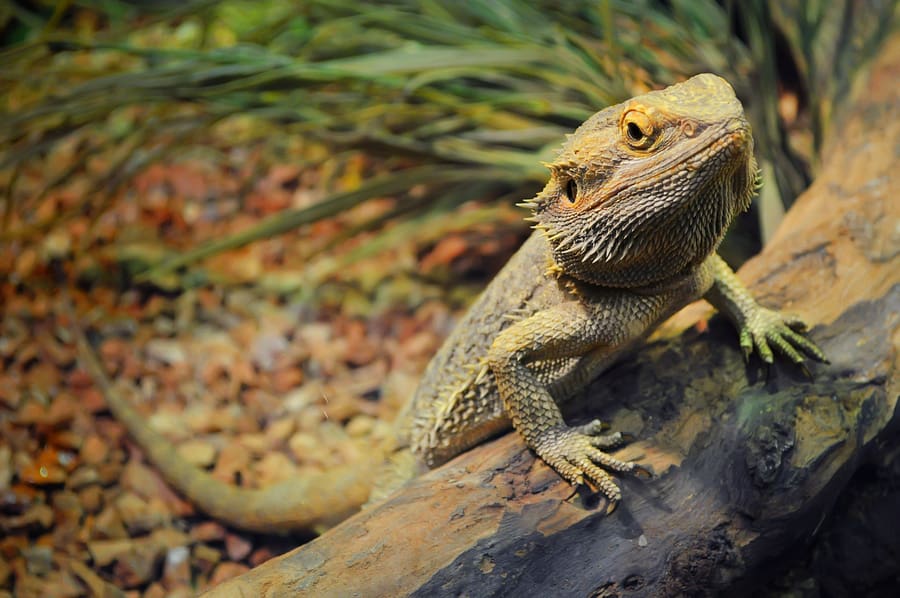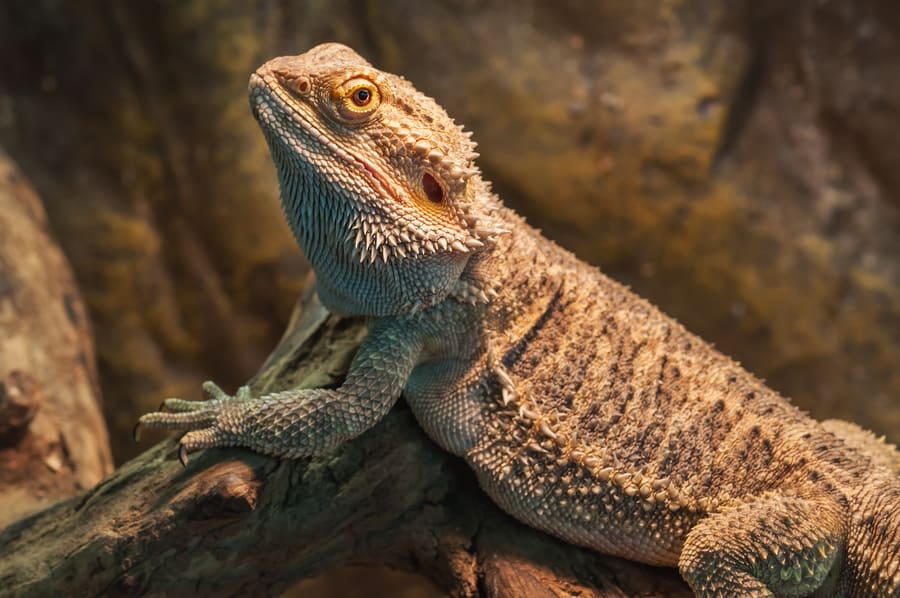
Whether you’re a new bearded dragon owner or thinking about getting a beardie, it’s important to know how temperature affects your bearded dragon. So, are bearded dragons cool to touch?
Because bearded dragons are cold-blooded, their skin temperature depends on their environment. They will feel cool to the touch if they have been hiding in a burrow or cooler part of their tank.
If your bearded dragon has been basking under its heat lamp, then it might feel warm to the touch, but if your bearded dragon has been hiding in its burrow or relaxing in a cooler part of the tank, then it might feel cool to the touch.
If your bearded dragon is cold and has other symptoms, a cool-feeling bearded dragon may be a sign of other health problems, a vivarium that’s too cold, or because of brumation. The temperature of your bearded dragon’s skin can tell you a lot about its health and environment, so read on to learn what skin temperature can mean and how to set up the perfect temperature in your vivarium.
Are Bearded Dragons Cold to the Touch?
Your bearded dragon should not be cold to touch; there’s a difference between “cool” and “cold.” I would describe cool as the feeling of grass that’s been in the shade on a warm summer day, so not cold but not necessarily warm.
If your bearded dragon is cold, on the other hand, you should check your vivarium’s temperature and monitor your dragon to make sure there aren’t any other symptoms (more on this below).
To make it easier to find the right temp for your dragon, I’ve made a temperature guide for babies, juveniles, and adults:
Babies (newborn-6 months)
| Body Temperature Based on Location (Babies) | Body Temperature |
| Daytime Basking Area of Tank | 95-110° F |
| Daytime Cooler Area of Tank | 80-90° F |
| Nighttime Temperature | 72-80° F |
Juveniles (6-18 months)
| Body Temperature Based on Location (Juveniles) | Body Temperature |
| Daytime Basking Area of Tank | 95-100° F |
| Daytime Cooler Area of Tank | 80-90° F |
| Nighttime Temperature | 72-80° F |
Adults (18+ months)
| Body Temperature Based on Location (Adults) | Body Temperature |
| Daytime Basking Area of Tank | 90-100° F |
| Daytime Cooler Area of Tank | 80-90° F |
| Nighttime Temperature | 72-80° F |
How Cold-Bloodedness Impacts Skin Temperature
Bearded dragons are cold-blooded, which means that they don’t maintain their body temperatures like humans and other mammals. Unlike warm-blooded animals, cold-blooded animals don’t have a set internal temperature, and their body temperature changes with the surrounding environment.
For example, if your dragon gets too cold, then it’ll go to the heat lamp to warm up; if your beardie gets too warm, then it’ll head to a cooler area of the vivarium to cool off.
So, what does this have to do with skin temperature? Well, this means that if your bearded dragon has been basking under the heat lamp, then it’ll feel warm to the touch. But if your beardie has been cooling off in the cooler part of the tank or emerging for the first time in the morning, its skin might feel cooler.
What Does a Cool-Feeling Bearded Dragon Tell Me?
Because bearded dragons are cold-blooded, they depend on their environment to help maintain their body temperature. While a basking beardie may feel warmer, there are many reasons why your bearded dragon feels cold. While some of these conditions could be life-threatening, not all of them are cause for concern.
Your dragon may feel colder depending on the time of day, where he’s is in the brumation process, if the vivarium’s temperature is too cold, if she’s sick, or due to early stages of their dying process. So, let’s explore each of these topics and learn what feeling cold can tell you about your bearded dragon.
Impacts on Body Temp: Time of Day
It’s perfectly normal for your bearded dragon’s skin to feel cooler in the morning. After all, your heat lamp has been off all night and your beardie’s vivarium temperature should have been lower than it was during the day to mimic the dragon’s natural habitat.
So, if your bearded dragon feels cool in the morning, don’t fret. Just turn on its heat lamp and check on it in a few hours.
Summary: A bearded dragon’s skin temperature will rise and fall throughout the day. Don’t be alarmed unless their body is cold or hot to the touch.
Impacts on Body Temp: Vivarium Temperature
If you notice that your bearded dragon isn’t as active as normal and feels cool to the touch, the first thing you should check is the temp in your vivarium. It’s always a good idea to have two thermostats in your vivarium (one for the basking area and one for your cooler area), so you should make sure to check both of them. If you’re concerned that your thermostat isn’t working, use a different one to double-check the temp.
If your temperatures are lower than the suggested range—see the bearded dragon temperature guide below for those specific numbers—then turn the temperature up in your vivarium. Once your bearded dragon has warmed up, its activity levels should go back to normal.
Impacts on Body Temp: Brumation
Basically, brumation is reptile hibernation. While the symptoms can scare even the most seasoned Dragon owner, brumation is completely natural. The most common symptoms include:
- Decreased appetite and drinking (due to drop in metabolism)
- Decrease in urination and defecating
- Sleeping a lot more than normal
- Prefers cooler parts of the tank
Brumation in captivity may look a little different than it does in the wild. First of all, not all bearded dragons will brumate in captivity. And, some dragons will brumate in seasons other than winter, so it’s not unheard of for your beardie to brumate in the middle of the summer.
Impacts on Body Temp: Sick or End of Life
If your vivarium temperature is perfect, you’ve decided that the symptoms you’re seeing aren’t those of brumation, and your beardie is cold at all hours, then your beardie may be sick or near the end of its natural life. Some symptoms to look out for include:
- Pale skin
- Sunken eyes
- Discolored skin
- No appetite (even for favorite treats)
- No energy
- No longer basking
Notice: If you notice that your bearded dragon has any of the above symptoms, it may be time to call your vet.
At What Point (Cold-Wise) Should I Be Concerned?
Cold is only concerning if your bearded dragon’s vivarium has been less than 70° Fahrenheit for an extended period of time (24 hours or more) or if it’s paired with other symptoms. Generally, a cold bearded dragon will not be very active.
If you see that your bearded dragon isn’t walking around like normal, isn’t eating, and overall isn’t acting normally, it may be too cold. But if your bearded dragon is cold to the touch even after you’ve decided that your tank is at the right temperature and brumation isn’t occurring, there may be something else that’s bothering your dragon.
Additionally, if you notice that your beardie’s eyes are sunken, looks pale, won’t touch his favorite treats, or has stopped basking altogether, then it may be time to consult your vet.
What Happens if the Bearded Dragon Gets Too Cold?
Because bearded dragons are cold-blooded, it can be dangerous if they get too cold. When your Dragon gets too cold, its body can’t function properly. While the inability to digest food is likely the most life-threatening problem because your dragon’s food might begin to rot in its stomach, other issues you may notice include:
- Slow or little movement
- Reduced or no appetite
- Constipation/impaction (read below to find out more about what this is)
- Inability to urinate
- Sleepiness (sometimes to the point where it’s hard to wake up)
Generally, a few hours without heat won’t cause serious damage. But, if your beardie doesn’t have heat for 24 hours or more, you may need to consider taking it to the vet. You know your dragon best, so if it’s not acting normally, give your vet a call and choose the best action from there.

Optimum Temperature Bearded Dragon Temperature
The optimum body temperature for a bearded dragon is 35° Celsius, or 95° Fahrenheit, according to Smith et. al. (2016).
What Temperature Should My Bearded Dragon’s Tank Be?
The goal of making the best bearded dragon tank is to try as best you can to mimic their natural environment. So, you’ll want warmer temperatures in the day and drop the temperature at night.
Bearded dragons like to bask in the sun, so your vivarium needs a heat lamp to act as your heat source. In the wild, dragons might burrow underground if they get too warm, so you’ll also need a cooler area in your tank for your beardie to cool off if it needs to.
When creating the perfect environment for your bearded dragon, having the right temperatures are important. During the day, bearded dragons need both a basking area and a cooler area. While it was probably given away by the names, the basking area is going to be warmer than the cooler area.
Besides the different temperatures within one tank, the age of your beardie also impacts what temperature range your tank should be.
Now, I know what you’re thinking: how am I going to make sure my beardie’s tank is at the right temp all the time? While it should be easy enough to turn your heat lamps on and off, you could even buy a light timer if you’re interested.
Also, many bearded dragon owners have found that placing a thermostat in the cooler and warmer spots in the tank make it much easier to monitor the temperature. If you’re temperatures fluctuate and aren’t exactly within the range, don’t worry.
You’ll likely find a variety of ranges of temps all over the internet, and the above table is the average of them all. The most important thing is that your bearded dragon is warm enough and that your temperatures stay above 70° Fahrenheit.
What About Humidity?
Bearded dragons come from a dry environment, so high humidity is not recommended for your beardie. Generally, bearded dragons should be kept at 30% to 40% humidity. According to the School of Veterinary Science from the University of Queensland, high humidity can cause blistering and dermatitis, but low humidity can cause abnormal shedding.
So, it may be worth it to get a humidity tracking system along with your thermostat. On Amazon, you can find systems that track both temp and humidity on the same sensor.
Do Bearded Dragons Require a Heat Lamp
Even if you live in the scorching deserts of Arizona, your bearded dragon should have a heat lamp. Beardies are exothermic, which means they need to get their heat from an outside source. In the dry woodlands and deserts of their native home in central Australia, bearded dragons get their heat from basking in the sun. In an indoor enclosure, they’ll get the warmth they need from a heat lamp.
In fact, heat lamps are super important to your beardie’s health. Once domestic bearded dragons have eaten, they need to sit under their heat lamp to digest their food. The warmth on their bellies helps them absorb nutrients and digest properly.
Without a heat lamp, your bearded dragon may have trouble digesting its food and suffer from impaction. Impaction is mostly caused when food and other materials aren’t digested and leads to constipation. Constipation is uncomfortable when it happens to humans, and dragons are no different.
You might notice that your dragon loses its appetite, doesn’t move as well, and seems a little moody. Luckily, impaction can be easily avoided if you set up a heat lamp in your beardie’s tank.
Will Bearded Dragons Also Get Warm to the Touch?
Yes, your bearded dragon can feel warm to the touch. But it depends on the time of day and whether your bearded dragon has been basking under its heat lamp or resting in the cooler areas of the tank. Because bearded dragons are cold-blooded, the temperature of their skin will change with their surrounding environment.
So, if you pick up your bearded dragon after it has been under her heat lamp, it’ll feel warm. In fact, your beardie should feel warm (but not hot) most of the time. As we explored above, a cold-feeling bearded dragon can mean quite a few things relating to his health.
What are Dangerous Temperatures for Bearded Dragons?
Maintaining the perfect habitat for your bearded dragon is a science, but what temperatures are too hot and cold for your bearded dragon?
Temperatures That Are Too Hot for Your Bearded Dragon
Bearded dragons can get too hot, and this can be dangerous. Generally, your basking area should not exceed 110° Fahrenheit. If the thermostat in your basking area reads anywhere from 115 to 120° Fahrenheit, your bearded dragon may show signs of overheating, such as panting more than normal, trying to climb the glass/escape, or excessively digging.
Temperatures That Are Too Cold for Your Bearded Dragon
Temperatures below 70° Fahrenheit are too cold for your bearded dragon. The cold temps become especially dangerous if they are below 65° Fahrenheit for long periods of time. If your heat lamp goes out or for some reason you lose power for a few hours, your bearded dragon should be just fine. However, if your dragon goes for a prolonged period without heat, it could be life-threatening. If this occurs, call your vet and proceed from there.
